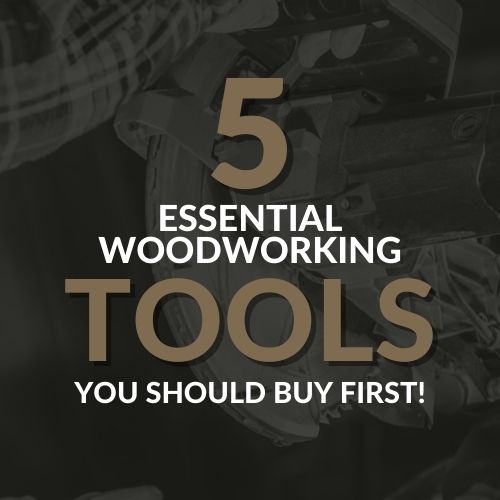5 Woodworking Tools To Buy First
September 29, 2020
When you are first starting out, it can feel extremely overwhelmed with what woodworking tools you should buy. Below is my list of the top 5 most important woodworking tools to purchase as you are starting out.
I include links to the tools that I am currently using in hopes it helps. The link provides all of the product details, but if you have a question about my experience with it, let me know. Many of my tools are from DEWALT. I find their tools to be reasonably priced for a great quality product.
Full disclosure, these links are affiliate links. That means if you purchase an item through that link, I may earn a commission at no additional cost to you. Please know that I only make recommendations for products I am currently or have previously used and feel are a worthwhile investment. Authenticity is important to me and so is your trust.
1. Table Saw
Your initial instinct when purchasing a saw will probably be a miter saw or “chop saw”. While a miter saw is a useful tool, you can do everything and more with a table saw. The table saw is extremely versatile especially if you take the time to build the proper jigs. Check out my blog about jigs that you can make on a table saw here. There is a huge range of table saws out there. You can buy new ones for just over $100, to a few hundred, up to thousands of dollars. Here is my advice: if you plan on really pursuing this passion buy the most saw you can afford. The price tag hurts at first but quality pays itself back over and over.
2. Circular Saw
You may be wondering why I started with two saws back to back. Well because you are always going to have to cut your wood to size! My reasoning behind a circular saw over a miter saw is price and versatility. Circular saws are going to be much more affordable. Plus they can break down boards just like a miter saw and conquer sheet goods which you can’t do with a miter saw. Plus, if you get a nice straight edge, you can get very long straight cuts that won’t fit on your table saw.
3. Combination Square
OK—so we’ve talked a lot about cutting your wood down to size but we haven’t talked about how you are going to know where to cut. That’s where the combination square comes in. These tools will help you get accurate layout marks. These tools will also be useful when adjusting your tools for proper dial-in.
4. Drill/Impact
We’ve covered marking and sawing boards, now we’re gonna talk about putting them back together. As a beginner, you’re not going to be tackling mortise and tenon or dovetails joints right away. You’re going to be screwing things together most likely. A drill is going to allow you to drill any holes you may need in your project but also get everything secured back together. I do recommend with a drill that it is cordless since you’ll be taking it all over your shop.
5. Dust Collection
This one probably doesn’t show up on many other first tool lists. When I say dust collection I’m not talking about some thousand dollar system with automatic waste gates and metal ducting. Although if you can do that, we are all jealous of you and for good reason. Dust collection can be as simple as a shopvac that you take around with you. But keeping your shop clean is so important and minimizing sawdust is critical to your health. We want our woodworking community healthy and happy!


[…] And during this phase, embrace lower-cost efforts while you can. You will start out using your own money and the last thing you want to do is have to completely press pause because you over-spent. So, what is the tip? Home Depot, Lowes, Menards, any big box store… use them. They offer a nice selection of wood and you should use that to build your workspace. When it comes to tools, check out this list of 5 that you actually need to start (effectively). […]